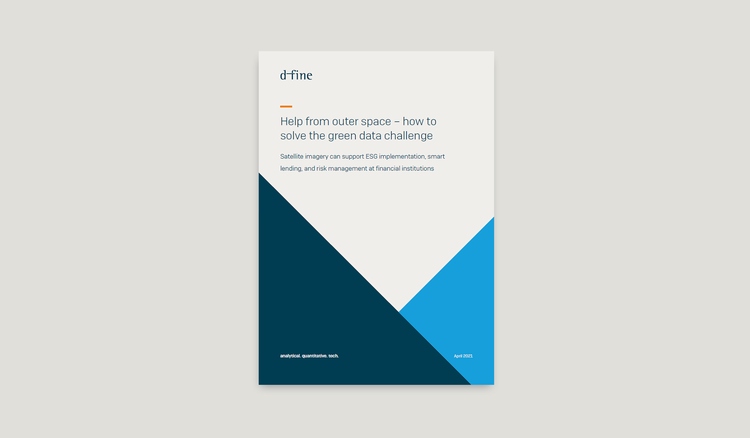- Our DNA
- Expertise
Our industry expertise
d-fine has the experts with the relevant project experience from your industry. Find out more about our services for your industry:
- Banking & Capital MarketsFintechs & Neobanks, Exchanges & Clearing Houses, Supervisory Authorities & Central Banks, Industry Associations & Service Providers
- Insurance & Asset ManagementProperty & Casualty Insurance, Life & Health Insurance, Re-Insurance, Capital Management Companies, Asset Management, Pension Funds
- Energy & IndustrialsEnergy, Chemicals, Industrials, Utilities, Construction, Logistics
- HealthcareLife Sciences, Pharma, Distribution, Medtech, Care
- Consumer & ServicesConsumer Products, Retail, Mobility, Real Estate Operations, Transportation, Automotive, Sports
- TechnologyTelecom, Media, Infrastructure, Software
- Public SectorGovernment, Agencies & Regulators, Research, Public Health, Public Companies, Public Transport, NGOs & Non-Profits
- Insights
- Career
- Locations

Digital Finance
"The future of finance is digital."
(Valdis Dombrovskis)
The digital transformation is one of the central topics for the upcoming years in the financial sector. At EU level, this process is accompanied by numerous legislative measures, among other things, as part of the "Digital Finance Strategy". We support you in seizing the full potential of digital innovations without neglecting the associated risks.
Key EU Initiatives
Markets in Crypto Assets (MiCA) & DLT Pilot Regime
A harmonised framework for issuers and services providers of crypto assets (MiCA), that are not covered by existing financial legislation, and a pilot regime for trading and settlement infrastructures based on distributed ledger technology
In force since 06/2022 (DLT) and 06/2023 (MiCA)
Digital Operational Resilience Act (DORA)
DORA formulates uniform requirements concerning IT risks, security incidents and service providers to ensure operational resilience of the financial sector
In force since 01/2023
Artificial Intelligence Act (AIA)
(Risk-based) rules for the development, deployment and usage of systems that employ artificial intelligence (AI) techniques – including product components and stand-alone systems
Provisional agreement 12/2024
Financial Data Access Regulation / Open Finance
Rules for the sharing and use of customer-permissioned data by banks and third party providers to create tailor-made financial services
Proposal published 06/2023
European Single Access Point (ESAP)
Facilitated access to disclosed information relevant to capital markets in standardised and machine-readable formats via the European Single Access Point (ESAP)
In force since 01/2024
SupTech, RegTech & integrated reporting
Harmonised requirements for automated reporting in standardised and machine-readable formats to promote the use of RegTech and SupTech tools
Supervisory Data Strategy + Feasibility study of an integrated reporting system published 12/2021
Retail payments strategy
Creating competitive and fair EU-wide retail payment markets to offer innovative and state-of-the-art payment solutions
Instant payment proposal: Provisional agreement 11/2023; proposals on PSD3, PSR & digital euro published 06/2023
Harmonised customer onboarding
Convergence of customer due diligence (CDD) requirements building on interoperable digital identities and conditions for the reuse of CDD information for other purposes
EUid & AML/CFT package: Provisional agreement 06/2023 & 01/2024; EBA guidelines: in force since 10/2023
d-fine Regulatory Map
Today, EU regulation in banking and finance is formed by a multitude of legal norms continuously evolving by the interplay of numerous designated parties. To remain up-to-date and keep an overview of the resulting broad range of interlaced publications in various stages of development poses a considerable challenge in terms of accuracy, time and cost for users and supervisors alike.
The d-fine Regulatory Map offers a unique overview of EU regulation in selected policy areas including a comprehensive set of text views to allow for an in-depth analysis.








